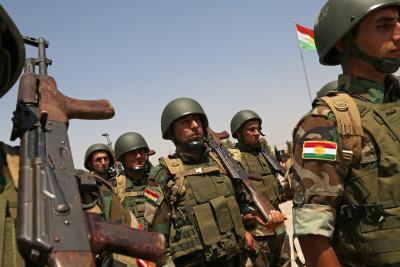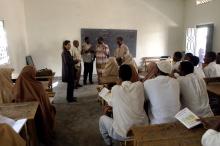Case prepared by Haya Omari, Andreas Piperides and Naomi Smith, LL.M. students at Leiden University under the supervision of Professor Robert Heinsch as well as Sofia Poulopoulou and Daniel Møgster (PhD researcher/researcher), Kalshoven-Gieskes Forum, Leiden University.
A. OFFICIAL DECREE INSTRUCTING THE PESHMERGA OFFICERS AND COMMANDERS
[...]
An official decree was issued by President Masoud Barzani on March 17, 2016, immediately after the commencement of liberating ISIS [Islamic State of Iraq and Syria] controlled areas. The decree contains the following instructions pursuant to the Kurdistan Region’s [KR] amended Presidential Law of 2005 and with consideration to the KR’s security situation in its fight against the terrorist organization, ISIS. To protect human rights during battle and “preserve the respectable stance of the reputable Peshmerga forces”, President Barzani instructed all the Peshmerga officers and commanders of the following:
1. Reiterating the implementation of Decree No. 120 of August 21, 2014 that was forwarded to the Ministries of Peshmerga and Interior, commanding to commit to high values during war against ISIS and protect civilian lives in the liberated areas.
2. Reaffirming that civilian lives must be protected and prevent the lootings, and destruction of their houses and villages in the liberated areas.
3. Remembering that civilians must not be arrested without a court warrant and sufficient evidence and their cases must be dealt in a legally timely manner.
4. Insisting that civilians must not be displaced from their areas without legal and military support.
5. The free movement of civilians in the areas, except in the areas near battle with ISIS, should be permitted.
6. Calling on respecting humanitarian laws and principles when treating with civilians in defense and front lines.
7. Warning that any violators of the above points will be held accountable.
B. EFFORTS AIMED AT INCREASING THE IHL KNOWLEDGE OF THE PESHMERGA FORCES
[…]
The way forward is marked by a continuation and expansion of present efforts aimed at enhancing adherence to IHL in Iraq’s fighting arena. At present, the Peshmerga has hosted a number of academics whose expertise on IHL and human rights has been shared widely with combatants and commanders alike. [...] To date, the ICRC has built the capacity of over 40 individuals within the Peshmerga to conduct trainings internally, establishing a code of conduct for combatants, and defining the principles of roles in conflict.
[...]
Finally, the MoP [Ministry of Peshmerga] in partnership with the ICRC has developed and distributed a manual outlining the principles of the protection of human rights and compliance with IHL, clearly specifying their policy and expectations. It is essential that the KRG [Kurdish Regional Government] actively demonstrates its commitment to upholding and respecting IHL by creating and reinforcing mechanisms to address violations of international law. Where such mechanisms are absent, or where their implementation has failed in practice, improvements should be made by developing and enforcing additional mechanisms of accountability.
[...]
C. LAUNCH OF THE FIRST CODE OF CONDUCT FOR THE PESHMERGA FORCES
[Source: Kurdistan Regional Government Ministry of Peshmerga, Code of Conduct for the Peshmerga, 5 December 2018, available at: Link not available.]
“Peshmerga is a Fighter, Not Killer”
The Peshmerga Forces under the Ministry of Peshmerga are professional military forces and are fully determined to comply with the Code of Conduct. Adherence to the code of conduct is an inherent commitment and part of the training of the Peshmerga forces on behaving and performing his/her duties in a responsible way while respecting humanitarian principles in all situations, but in specific to, situations of armed conflict.
With this, I, as a member of the Peshmerga Forces, pledge to abide by the following rules:
Rule 1: I only engage in military objectives and I do not attack civilians or civilian objects.
Rule 2: When engaging military objectives, I ensure that expected collateral damage is not excessive to the expected military advantage. I take all feasible precautions to avoid or minimize collateral damage.
Rule 3: I do not use prohibited weapons or engage in any methods of warfare that do not comply with the rules listed in this code of conduct.
Rule 4: As soon as, the war situation permits, I will do my very best to collect and care for the wounded, sick and dead, whether friend or enemy and provide information, if any, on missing persons. At the same time, I will be cautious to assure safety of myself and my Peshmerga fellows.
Rule 5: I treat all people humanely and respect their fundamental rights. I do not harm those fighters or civilians who surrender or detained or otherwise come under my control. Torture of detainees and prisoners of war is totally prohibited.
Rule 6: I do not take hostages or use them and civilians as human shields. I avoid locating my military objects near or amongst civilian populations and civilian objects. I commit to respect the places of religious and cultural origins.
Rule 7: I ensure to safeguard civilian population and respect their private and public properties.
Rule 8: I do not displace the civilian populations unless required for their own security or imperative military reasons. I allow and facilitate the displaced populations to resettle in accordance with their own free will. Displacement of the civilian population must not last longer than absolutely necessary.
Rule 9: I respect women and do not commit or permit rape or sexual abuse against anyone.
Rule 10: I make sure that children have the aid and care they require and I refrain from attacks on schools and I don’t use schools as military objects unless required for imperative military reasons for a very short period of time. Any forced and voluntary recruitment of children below the age of 18 years old and using them as hostilities is totally prohibited.
Rule 11: I allow and facilitate humanitarian relief for civilians in need.
Rule 12: I respect and protect medical teams and objects, including those bearing the Red Cross/Red Crescent/Red Crystals, and other symbols of humanitarians and media agencies. Any unlawful use of such symbols is prohibited.
Rule 13: I abstain from reprisals and any inhuman and brutal acts of vengeance in violation of LOAC (law of armed conflict) even if my enemy commits such violations.
Rule 14: I, solely, pledge to abide by and respect the sanctity of this code of conduct based on law of armed conflict. Any violations are totally prohibited and whoever commits such violations will be sanctioned and face military sentences according to the violation. Torture or other inhuman or degrading treatments are strictly prohibited when applying these sanctions.
Discussion
I. Classification of the Situation and Applicable Law
1. How would you classify the situation in Iraq from 2014 to 2018 involving ISIS? Was there an armed conflict? If yes, who were the Parties to it? What additional information would you require in order to make such a determination? (
GC I-IV, Art. 3)
2. Does classification of the situation affect the applicability of IHL obligations linked to the adoption of the Code of Conduct and dissemination of IHL among the armed forces?
II. The Presidential Decree and the Code of Conduct for the Peshmerga Forces
3. Does the Kurdistan Regional Government (KRG) have a duty to regulate the conduct of the Peshmerga forces? Does IHL oblige Parties to the conflict to issue instructions and codes of conduct to their fighting forces? What is the role and importance of such instruments? (
GC I-IV, Art. 3;
CIHL, Rules 139, 142)
4. Do you think that codes of conduct are sufficient to ensure respect for IHL? What other implementation mechanisms could the parties to the conflict introduce and use in order to ensure compliance with IHL?
III. Elements Contributing to Respect for IHL
6. (Document A and C) In your opinion, what motivated the Peshmerga forces to adopt a code of conduct and to adhere to IHL principles? Why is it important to “preserve the respectable stance of the reputable Peshmerga forces” as affirmed in the Presidential Decree? In your opinion, why were Peshmerga forces commanded to “commit to high values during war against ISIS”? Do you think that the interest of the fighting parties to keep the good image may contribute to respect for IHL?
7. What is the added value for the Peshmerga forces to issue their own code of conduct? Do you think that it allows them to take ownership of humanitarian norms? Can such ownership contribute to better compliance with IHL standards during armed conflicts?
8. (Document C) Do you think there is a link between the “professionalism” of the armed forces and respect for IHL? Is there an interest for the armed forces to have professionally trained and disciplined armed forces? Does military routine contribute to respect for IHL? Why would military commanders and political leaders want to make sure that their armed forces are familiar with legal standards and that its members do not engage in violations of the law? Does command or superior responsibility for potential violations committed by the subordinates have a role to play in it?
9. (Document A and C) Do you think that accountability mechanisms for violations of IHL as set out in the Presidential Decree and Rule 14 of the new code of conduct have a role to play in respect for the law by the individual members of armed forces? Why is it important to hold individuals accountable for violations of IHL? Can such mechanisms deter future violations and ensure respect for IHL?
10. (Document A) Why you think that KRG may want to limit the destruction of civilian infrastructure in liberated areas? Do you think that apart from humanitarian aspirations and commitment to comply with the law, parties to the conflict may also have economic and political interests? To win the “hearts and minds” of the local population? To save resources that would otherwise be needed for the reconstruction of the infrastructure in liberated areas?





